Monday Oct 20, 2025
Monday Oct 20, 2025
Friday, 4 October 2024 00:20 - - {{hitsCtrl.values.hits}}
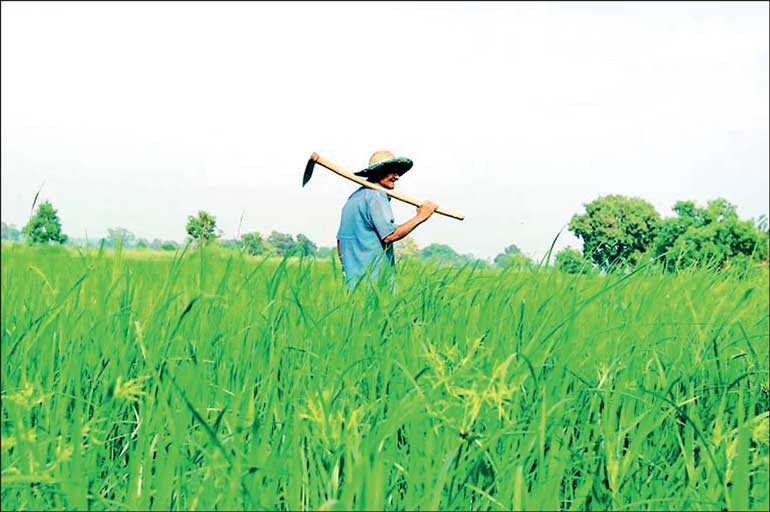
The inefficiencies in the entire food system should be minimised to provide high quality rice at an affordable price to the consumer, without causing economic disadvantages to the producer
 Sri Lanka has elected its 9th Executive President. How the election was won and finding reasons for the defeat of other parties may be politically important. However, more focus should be placed on the country’s development, at a time when we are struggling to transform from an apparent stable economy to a growing economy. It is not easy to make ‘miracle’ changes, but there is no “ifs or buts” that Sri Lanka should move forward along sustainable development paths. I would like to rate financial management, energy, food and agriculture, education, health, and climate change and environment as priority areas in the overall economy. Among them, this article focuses on selected segments of the food and agriculture sector. Although discussed in isolation, I wish to emphasise that the way forward in the sector should be harmonised with other economic sectors to ensure its true sense of advancement. Political will and courage to make sound and effective decisions are indeed crucial in such efforts.
Sri Lanka has elected its 9th Executive President. How the election was won and finding reasons for the defeat of other parties may be politically important. However, more focus should be placed on the country’s development, at a time when we are struggling to transform from an apparent stable economy to a growing economy. It is not easy to make ‘miracle’ changes, but there is no “ifs or buts” that Sri Lanka should move forward along sustainable development paths. I would like to rate financial management, energy, food and agriculture, education, health, and climate change and environment as priority areas in the overall economy. Among them, this article focuses on selected segments of the food and agriculture sector. Although discussed in isolation, I wish to emphasise that the way forward in the sector should be harmonised with other economic sectors to ensure its true sense of advancement. Political will and courage to make sound and effective decisions are indeed crucial in such efforts.
First, it is important to realise that a country’s food security cannot be achieved entirely through national agricultural production. We need food imports to fill voids in the food requirements resulting from climate change and other disasters (assuming no policy-level blunders), and to support the tourism industry. However, we should maximise the contribution of the agricultural sector (crop and animal production including aquaculture) to the overall food security of the country.
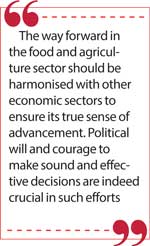 Agriculture not only provides food for direct human consumption, but also the basic inputs required for agro-based industries. We consume fruits and vegetables in the raw and processed forms. Cereals such as rice and maize, and legumes, tubers, etc. need to be processed before human consumption. Maize and rice are also important raw materials for animal feed supporting animal-based food production to overcome protein malnutrition in the country.
Agriculture not only provides food for direct human consumption, but also the basic inputs required for agro-based industries. We consume fruits and vegetables in the raw and processed forms. Cereals such as rice and maize, and legumes, tubers, etc. need to be processed before human consumption. Maize and rice are also important raw materials for animal feed supporting animal-based food production to overcome protein malnutrition in the country.
According to the government Department of Agriculture (DOA), the per capita consumption of rice (de-husked paddy) in Sri Lanka has increased from 107 kg per year to 112.3 kg per year over the last 5 years. The national demand for rice has increased indicating the need for increased paddy production. Our paddy production was reduced by 34% in 2022 due to irrational policy decisions taken in 2021. The limitation of land for cultivation emphasises the need to increase land productivity (production per unit land area). New technology and scientific knowledge and skills on using them will make a special contribution to accomplish this goal. For example, our scientists have developed high yielding varieties which are cultivated in about 98% of paddy fields in the country.
Resilience
We have found solutions to tackle climate change; e.g. the DOA has developed drought resistant rice varieties (e.g. Bg 251 and Bg 314), introduced Good Agricultural Practices (GAP) to revive paddy production that collapsed due to the poor policies, etc. When it comes to plantation crops, the Tea Research Institute has released a drought tolerant TRI 5000 series tea cultivar to boost the tea production under climate threats. Those are few examples to show that the country has shown resilience and has bounced back after the impact of natural or man-made disasters, highlighting our technical capacity, commitment, and technological orientation.
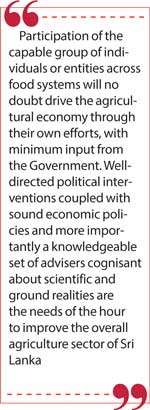 Moreover, we should not undermine the role played by major rice processing mills owned by the private sector and thus, we Sri Lankans have the opportunity to consume high quality rice. The rice processing industry needs to be further strengthened by developing facilities at the regional level considering paddy production capacity, regulating the paddy purchase by the private sector, improving the condition of storage facilities, and removing market inefficiencies. This needs to be planned and executed not by targeting to penalize the main rice processors (mill owners). This is where the political will and interventions would be essentially required.
Moreover, we should not undermine the role played by major rice processing mills owned by the private sector and thus, we Sri Lankans have the opportunity to consume high quality rice. The rice processing industry needs to be further strengthened by developing facilities at the regional level considering paddy production capacity, regulating the paddy purchase by the private sector, improving the condition of storage facilities, and removing market inefficiencies. This needs to be planned and executed not by targeting to penalize the main rice processors (mill owners). This is where the political will and interventions would be essentially required.
The distance travelled by food from the farm and time taken to reach consumers should be carefully analysed to support decision making to reduce “food miles”, food losses and consumer prices. A recent analysis done by Faculty of Agriculture of University of Peradeniya, with operational support from six other Faculties of Agriculture, and financial support from the Food and Agriculture Organization of the United Nations (FAO) and International Water Management Institute (IWMI) would provide some insights to such an effort. This “food system” study including paddy/rice, maize, beans, banana, potato, chicken meat and marine fish as food commodities, highlighted that minimizing inefficiencies in the entire food system should to provide high quality food at an affordable price to the consumer, without an economic disadvantages to the producer.
Fluctuations
of price of rice
Unfortunately, the country has paid more focus on the farmer at the beginning of a cultivating season (ignoring consumer) and focused more on the consumer at the time of harvest. This has dramatically affected the fluctuations of price of rice and other food products. Joint decision-making on cost of primary production (e.g. paddy) and price of processed product (e.g. rice) should be made with representative participation of all focal units in the food system (e.g.: input supplier–farmer–collector–processor–transporter–wholesaler–retailer–consumer) to help determining the overall price structures. A controlled price cannot stand for many years. Pre- and end-season consultation with appropriate modifications will help support all players in the food system with fair profit margins and affordable prices to the consumers. We need to build on the work done in the past, without starting from square one.
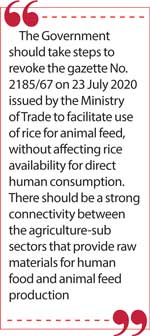 The poultry industry in Sri Lanka was on the verge of collapse due to the shortage of local maize production (the main ingredient of animal feed). About 83% of our total maize requirement goes for poultry feed production, 3% for other animal feed, 7% for human consumption (immature cobs), and 6% for producing high nutritional feed like “Thriphosha” and “Samaposha”, and 1% for alcohol production.
The poultry industry in Sri Lanka was on the verge of collapse due to the shortage of local maize production (the main ingredient of animal feed). About 83% of our total maize requirement goes for poultry feed production, 3% for other animal feed, 7% for human consumption (immature cobs), and 6% for producing high nutritional feed like “Thriphosha” and “Samaposha”, and 1% for alcohol production.
The local maize production was negatively affected due to the absence of fertiliser and pesticides and shortage of foreign exchange in importing maize and other inputs, leading to their high market prices. This situation was aggravated by the ban imposed in 2020 on using rice as an ingredient of animal feed. These changes led to an unprecedented increase in the price of chicken meat and especially eggs (from Rs. 15 to Rs. 70) causing significant inconvenience to consumers. With respect to nutritional needs of humans, shortage of the main staple that supply energy component of the diet can be addressed in the short-run with starchy alternatives, but the weakness caused by protein deficiency especially in pregnant women, nursing mothers and young children, cannot be easily resolved, and will have serious long-term negative effects on the overall population and economic development. Further, the Government should take steps to revoke the gazette No. 2185/67 on 23 July 2020 issued by the Ministry of Trade to facilitate use of rice for animal feed, without affecting rice availability for direct human consumption. There should be a strong connectivity between the agriculture-sub sectors that provide raw materials for human food and animal feed production.
In general, Sri Lankans consume about 3000 million eggs every year, however, its short supply led the Government to import about 94 million eggs from India in the recent past. In the last few days, we have experienced a drop in egg prices, which is good news for consumers. However, it seems that there is an “over production” so that producers sell eggs at an economic loss. But, the power of absorbing market shocks mainly depends on the scale of operation. Though the low egg prices in the market seems attractive, immediate measures should be taken to ensure that the chicken industry will not face another crisis where the small scale and medium-scale chicken farmers (meat and egg) would perish economically, resulting in a vicious cycle. Providing raw materials (e.g. maize) inadequate quantities to the poultry industry is the way out.
Interrelationship between crop cultivation and animal husbandry
Although it seems difficult to produce the maize requirement locally, the Government should guide the primary producers and private sector, empowering them with scientific knowledge and skills, and facilitating provision of better planting material and management packages. We should never ignore the interrelationship between crop cultivation and animal husbandry. Policy/political level decision making in these lines is a must for furthering the advances in the agriculture sector.
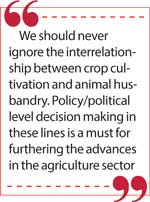 Knowing the present and future need for maize, including estimated annual growth rate of the poultry industry, the DOA has developed maize hybrids locally, yielding as high as imported maize hybrids. It is commendable that new varieties have also been introduced by the private sector through breeding programs. The need now is to popularise those through private-public partnerships with the involvement of DOA and Department of Animal Production and Health, and produce adequate quantities of seeds as planting material. This does not mean that importation of hybrid maize seeds for planting should be stopped, which may just be even a political slogan. What is required is to take correct decisions at the right time with futuristic targets, and implement them to avoid any gluts or shortages.
Knowing the present and future need for maize, including estimated annual growth rate of the poultry industry, the DOA has developed maize hybrids locally, yielding as high as imported maize hybrids. It is commendable that new varieties have also been introduced by the private sector through breeding programs. The need now is to popularise those through private-public partnerships with the involvement of DOA and Department of Animal Production and Health, and produce adequate quantities of seeds as planting material. This does not mean that importation of hybrid maize seeds for planting should be stopped, which may just be even a political slogan. What is required is to take correct decisions at the right time with futuristic targets, and implement them to avoid any gluts or shortages.
Tea sector in Sri Lanka has also undergone various ups and downs in the past. Due to lack of chemical fertilisers and pesticides, the total tea production declined by 17% in 2022, and is still to recover. However, many tea estates in Sri Lanka have shown a declining yield mainly due to the ageing tea bushes, which is a key biological limiting factor. Tea bushes usually give maximum economic yields until 30-35 years, but in many places their current age exceeds 60 years. Replanting of tea estates was recommended at least at a rate of 2% per year. However, the high cost of operations (generally costing more than Rupees 4.5 million per hectare, with tea plants taking about 3 years to reach harvest) has hampered the replanting rate keeping well-below the expected levels. Regardless of the quantity of fertilizer added, senile tea bushes will not provide the required harvest. Therefore, paying more attention to re-planting through a credit scheme is an urgent need (in addition to solving other socio-economic issues).
Smart agricultural technologies
Finally, I would like to briefly touch on smart agricultural technologies. Making decisions based on data for efficient use of inputs and maintaining agricultural productivity and sustainability is popular in many countries today. Sri Lanka has also recently started using such sustainable agricultural technologies. For example, a paid-service is currently provided to paddy farmers through public-private-partnership in 64 Agrarian Service Centers (ASCs) to apply pesticides by using spray-drones. Adopting such technologies in crop and animal production would help in precise use of resources and reaching desired development goals in the agriculture sector effectively. More importantly, such technologies will help reduce the environmental burden from the Agriculture sector ensuring sustainability. It is clear that political interventions to encourage relevant sectors to move into smart agriculture, obviously with sound technological knowledge, would enhance the efficiency of resource utilisation and productivity.
The leap-jump forward or modernising of Sri Lanka’s agricultural economy will not take place just because of the availability of new technology. Such progression cannot be expected from those who are incompetent (unable to think scientifically) with no investment capacity. However, the contribution of those who are competent (equipped with technical knowhow) having investment capacity will take our agriculture to the next level. Agriculture provides a part of basic needs to those in abject poverty and any Government investment or subsidies targeting such groups will support their livelihood, but it is mostly a cost-factor to the overall economy. Participation of the competent group of individuals or entities across food systems will no doubt drive the agricultural economy through their own efforts, with minimum input from the Government. Well-directed political interventions coupled with sound economic policies and more importantly a knowledgeable set of advisers who are cognisant about scientific and ground realities are the needs of the hour to improve the overall agriculture sector of Sri Lanka.
(The writer is attached to the Faculty of Agriculture, University of Peradeniya.)